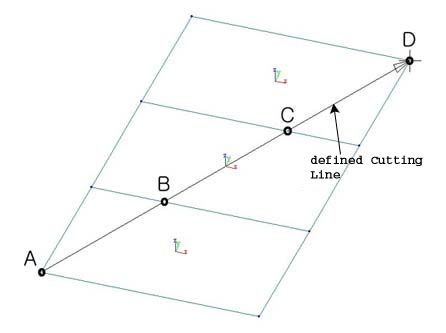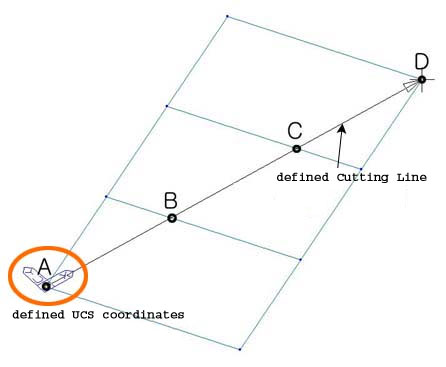Plate Cutting Line Diagram
Display the internal forces of plate elements along defined cross sectional lines in a graph.
From the Main Menu select Results > Results > Forces > Plate Cutting Line Diagram.
|
 Components
Components
Select the desired internal force component among the following:
Fxx: Axial force per unit width in the element's local or UCS x-direction (Perpendicular to local y-z plane)
Fyy: Axial force per unit width in the element's local or UCS y-direction (Perpendicular to local x-z plane)
Fxy: Shear force per unit width in the element's local or UCS x-y direction (In-plane shear)
Mxx: Bending moment per unit width in the direction of the element's local or UCS x-axis (Out-of-plane moment about local y-axis)
Myy: Bending moment per unit width in the direction of the element's local or UCS y-axis (Out-of-plane moment about local x-axis)
Mxy: Torsional moment per unit width about the element's local or UCS x-y plane
Vxx: Shear force per unit width in the direction of thickness of the x-axis direction defined by P0 and P1
Vyy: Shear force per unit width in the direction of thickness of the y-axis direction, which is perpendicular to the x-axis of the corresponding plane
 Options
Options
Define the plane and color for representing the graph.
|
Normal
In Plane
Scale Factor
Reverse
Graph
|
Express the graph normal to the plate elements.
Express the graph in the plane of plate elements.
Define the output scale ratio.
Express the graph in the opposite direction.
Produce the diagrams in graph windows.
|
|
|
Prompt the Plate Cutting Diagram Mode dialog box to determine the type of graph window. Draw graphs on separate panes: Produce a number of Plate Cutting Line Diagrams in separate graphs. All in one pane: Produce a number of Plate Cutting Line Diagrams all in one graph. X-Axis: Define the X-Axis of the graph. Distance from Pnt 1: The scale of the X-axis of the graph is drawn following the length of the cutting line starting from the first point. Global X Coord.: The scale of the X-axis of the graph is drawn on the basis of the cutting line projected on the Global X-axis. Global Y Coord.: The scale of the X-axis of the graph is drawn on the basis of the cutting line projected on the Global Y-axis. Global Z Coord.: The scale of the X-axis of the graph is drawn on the basis of the cutting line projected on the Global Z-axis. |
|
Value Output |
Produce the output in numerical values. |
|
MinMax Only |
Produce only minimum and maximum values if Value Output is selected. |
Note
The 'Cutting Line' option in Cutting Diagram of ![]() Plate Forces/Moments and
Plate Forces/Moments and ![]() Plate Cutting Line Diagram differ in the following aspects:
Plate Cutting Line Diagram differ in the following aspects:
1) When 'Cutting Line' of Cutting Diagram is executed after selecting 'Local' of Plate Force Option in Plate Forces/Moments,

In this case, the plate forces in ECS x or y axis can be obtained at the intersections between the plate elements and the Cutting Line at A, B, C & D. The limitation is that only a single force component or contour can be checked.
2) When 'Cutting Line' of Cutting Diagram is executed after selecting 'UCS' of Plate Force Option in Plate Forces/Moments

Similar to the case 1 above, the plate forces can be obtained but in UCS, which is defined in advance in the directions of force components of interests.
3) When Plate Cutting Diagram is executed, force components can be obtained in any desired coordinate system
This eliminates predefining UCS as in the case 2 above. However, contour is not provided in this function.